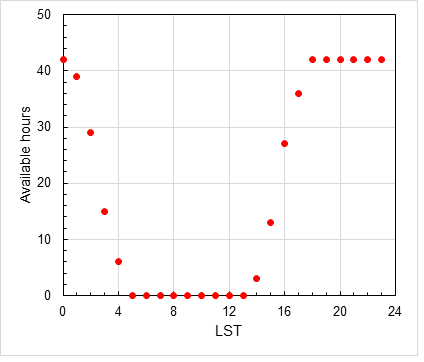Call for Proposals
Call For Proposals
February 7, 2020
The National Astronomical Observatory of Japan invites observing proposals for the Atacama Submillimeter Telescope Experiment (ASTE).
The Atacama Submillimeter Telescope Experiment (ASTE) is a project to promote ground-based observations at submillimeter wavelengths with a telescope in Atacama desert in Chile, operated by the National Astronomical Observatory of Japan (NAOJ), under the collaboration with University of Chile and Japanese Universities including University of Tokyo, Osaka Prefecture University, Ibaraki University, Hokkaido University, Keio University, and Joetsu University of Education. Single-beam spectroscopy observations in 321-376 GHz and 387-498 GHz bands are offered under the shared-risk basis. This opportunity is open to astronomers affiliated with institutes in Japan, Taiwan, and South Korea.
Shinichiro Asayama
Head of NAOJ Chile, National Astronomical Observatory of Japan
Available observing mode:
Single-beam spectroscopy observations in 350GHz-band (DASH345) and ASTE Band 8 with the WHSF spectrometer (FX mode only; 1/2/4 GHz bandwidth with 2048 channels) are offered for open-use proposals. Details of the receiver and the spectrometers are available on the instrumentation web page.
Scheduling period:
July 01 to August 31, 2020
Total observing time:
~370 hours between 15h - 03h in LST.
See below for the distribution of available time (total time of East Asia, Chile, and 10% contingency).

Submission deadline:
March 06, 2020 (15:00 JST or 6:00 UT)
Instruction and related information for observers:
Please visit the URL below to find instruction for proposal preparation and submission, updated reports on status of the telescope and instruments, and related information for observers.
- How to Prepare for ASTE Observing Proposals
- Instrumentation Overview
- We have obtained a set of demo science [CI] data toward RCW38. The data, along with instructions on how to calibrate the data, can be found at this link. Data reduction guide.
Proposal Template:
Proposers must use this template (LaTeX) for the science and technical justifications. No other formats are accepted. The scientific and technical justification, including figures, tables and references, must fit within 3 pages. The cover-page is generated online through the "Proposal Submission" page.
Proposal Categories:
- General This is the regular observing proposal, and the proposals can be submitted here.
- Joint observations with the 45m telescope Joint projects are not offered for this call for proposals.
- Guaranteed Time Observations The ASTE operation members can apply for Guaranteed Time Observations (GTO). The deadline for submission is the same as that for common-use proposals. If a GTO proposal duplicate a common-use proposal, the “Duplication rules (see below)” is also applicable to this case. Proposals can be submitted here.
- Directors Discretionary Time (DDT) DDT is not offered for this call for proposals.
Proposal Rules:
- Proposal must be written in English.
- Proposal must be prepared as a PDF file describing the scientific backgrounds, goals, plan/strategy of observations, estimation of observing time and related information.
- Proposals must be submitted through the online submission form, which is accessible from the "Proposal Submission" page. We do not accept proposal resubmission before and after the proposal deadline unless it is properly justified.
Proposal Evaluation:
The proposals are evaluated by the mm/submm Time Allocation Committee of the NAOJ, and the final time allocation is also made at the Time Allocation Committee. It is advised that the proposers clearly state the science value, uniqueness, and originality.
ASTE data delivery:
The full-size ASTE science data will be provided to the PIs through Nobeyama-45m/ASTE Science Data Archive within 1.5 months after their final observations.
Policy for data release:
From 2013 term, all ASTE raw data will be released after 1.5 years from the completion of the data delivery via the NAOJ archive. In addition, all ASTE data reduced by PI have to be submitted to the NAOJ Chile Observatory within 1.5 years after the completion of the data delivery. These ASTE data will be available for anonymous download from the NAOJ archive. In the case that a PI refuses to submit the reduced data, the NAOJ Chile Observatory will possibly reject a new ASTE proposal from the PI.
Duplication rules:
In ASTE, a duplication is defined as an observation of a same target, frequency and sensitivity. If a proposal duplicates others, only the highest ranked proposal will be allocated.
Guaranteed Time Observations:
The ASTE operation members can apply for Guaranteed Time Observations (GTO). The deadline for submission is the same as that for common-use proposals. If a GTO proposal duplicate a common-use proposal, the above “Duplication rules” is also applicable to this case.
Contact:
Questions should be directed to the helpdesk.
